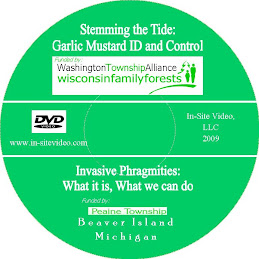Please keep in mind, that this video is being created for use by non-professional, inexperienced (or under/miss-educated) landowners and students. As you think about this project, keep in mind this population and what recommendations you might make to the "least of us".
For instance, without training and support personnel, would you recommend use of herbicides, garden torches, etc. in this particular video?
Hopefully, with future funding we will be able to add two vital components to this project. I will explain.
When Barbara Lucas' video on phragmities came to the attention of some of us in our community (thank you, Bill Olson), we saw it as a wonderful opportunity to educate our neighbors, and saw it a better opportunity if the video did not stand alone. So, we had a community gathering, invited our county invasive team leader up (Bob Bultman), showed the video, he answered questions and the next day we went on site with Bob for first hand experience and dialog. Those of us trained through that solid group of activities then distributed DVDs, put one in the library, went to people's living rooms to show the DVD and offered our help in controlling phragmities on their land. Folks could also look at the video online, but not many up here have high speed internet connections.
The hands on experience in the presence of an experienced expert, really propelled and validated the extent of the problem.
This is in contrast to the six or seven years we have spent trying to get our community (including Town Board, realtors, etc.) to take this problem seriously and to become active in controlling this invasive.
My experience with Wisconsin Family Forests and community forestry tells me that new landowners don't readily cope with big landscape projects such as big timber harvests using large equipment. We need small, smart initiatives which engage a whole spectrum of people.
Friday, March 14, 2008
Inexperienced Landowner/Student Target Audience
Posted by
Cindy Gaskill, Washington Township Alliance, Wisconsin Family Forests, Inc.
at
10:11 AM
1 comment:

Labels:
Video Outline
Monday, March 3, 2008
Please Comment on the Video Outline
Garlic Mustard Draft Outline - 3/3/08
How the plant got here
- Brought by colonists in 1860’s as a culinary herb
Why it has spread here
- No natural enemies (e.g. insects or fungi)
- Each plant produces hundreds of seeds
- Seeds stick to animal fur, shoes of walkers, car tires, etc., and also float downstream or are carried by the wind (most sources say wind isn’t a significant vector ??), to reach new territory
- Can spread by bringing compost, root stock, or transplants from infected areas
- Longevity of viable seeds in the ground—seeds can germinate at least five years after being produced.
- Extremely high density of growth shades out competition
- Inhibits mycorrhizal fungi that native plants, such as trees, require for growth
- High deer populations can facilitate its spread—
- White-tail deer rarely feed on it, instead they consume the competing native plants further assisting its spread
- Trampling by browsing deer encourages seed growth by disturbing the soil.
- Reduces the diversity of plants growing in forest understory
- This affects innumerable other species that depend on native plants
- Inhibits regeneration of forests—this can have long-term impacts on the ability of forests to provide habitat and beneficial ecosystem functions such as carbon fixation, oxygen production, erosion control, water retention, filtering of pollutants from water and air.
- Can become a “population sink”:
- e.g. some species of butterflies mistakenly lay their eggs on it instead of their usual host, but the larvae die once they hatch.
- Biennial
- Seedlings appear early spring, form a dense carpet
- Produces a non-flowering rosette first year which overwinters
- Flowers second year
- Flowers when pods are forming and are green and supple
- Seed pods turn brown and dry and drop seed
- Late summer the spent 2nd year plants coexist with first year plants on the rise
- Important to cut or pull before going to seed. Cutting is ineffective unless is done at ground level and at a specific time period (when plant is approaching/just beginning flowering stage).
- For large patches, start at the perimeter and work in, e.g start at the back of the infestation in the forest and move forward (which usually means moving toward the road.)
- Attack isolated infestations as soon as identified, before they spread out of control. This is especially important in areas that are sensitive and/or where control is difficult, such as wetlands.
- All roots should be removed—easiest when ground is wet—to prevent resprouting.
- The cut end of plants can continue growing and go to seed even without roots, so plant cannot be left on the ground, and never should be composted
- “Bag and trash” is best—follow the directions of your municipality for type of bag.
- Burning and/or chemical application has been used by professionals for large infestations.
- Rate of control after burning and herbicides has not always been satisfactory.
- These techniques can be dangerous to work with.
- They can kill “non-target” native plants and make the area vulnerable to new infestations as garlic mustard seedlings do best in disturbed soil.
- Biological control options are being researched, but the challenge is to find something that will kill garlic mustard while also being safe for native plants.
Resources for the most current information on control methods
Posted by
Cindy Gaskill, Washington Township Alliance, Wisconsin Family Forests, Inc.
at
4:00 PM
19 comments:

Labels:
Video Outline
Subscribe to:
Posts (Atom)
